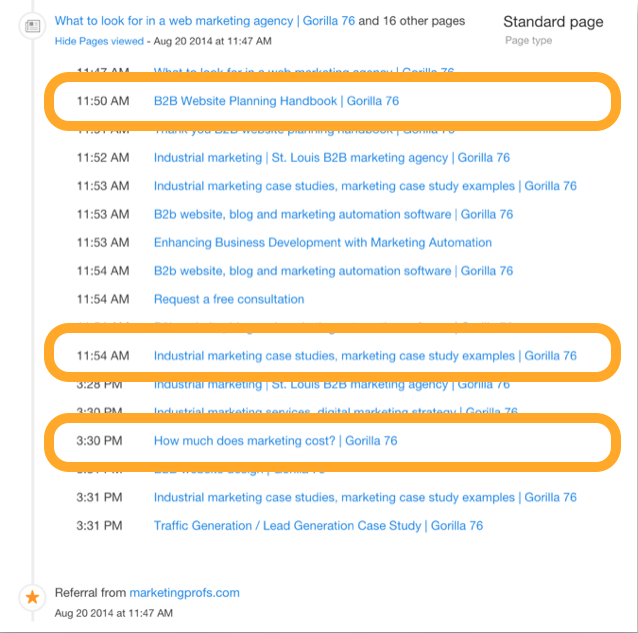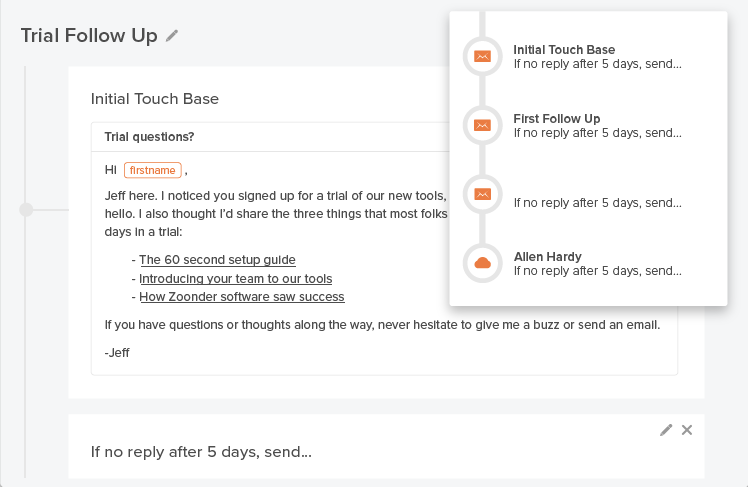As more industrial companies understand the opportunities of partnering marketing and sales teams together, manufacturers and subcontractors alike are becoming more sophisticated in how they communicate with prospects in the buying process. At the core of the marketing and sales partnership success is the customer relationship management (CRM) software that provides visibility on prospects, from discovering suppliers to closing deals.
A CRM can frame a lead’s needs and pain points through on-site behaviors. This enables the marketing team to understand where to focus future strategy and the sales team to cater conversations to those pain points and ultimately win more business.
Basics of Industrial Buying Behavior
To understand the behaviors of industrial buyers and how those translate into the lead data in a CRM, we should recap the key steps of the buyer’s process. The industrial buying process—while considerably longer than our consumer marketing counterparts—contains important steps that you can pinpoint to your prospect’s problems and address through content marketing solutions, e.g., educational articles or downloadable resources.
At the initial awareness step, leads are acknowledging a potential problem and researching the industry to understand their needs. In the simplest form, this may look like a “Know your Coatings: Alkyds vs Epoxies” article or a “Trends in Manufacturing Automation” blog post. When a prospect recognizes their problem and begins to identify their needs or potential solutions, they transition to the consideration or evaluation stage. These types of leads begin looking at your website for what you offer, focusing on capabilities pages, related certifications and product specifications. Both of these stages often go unnoticed by unsuspecting and ill-equipped competitors.
However, at each stage touch points can be initiated that aid in transitioning leads to the final decision stage. Most commonly seen by sales teams, this step in the buying process focuses on the quoting, negotiation and decision-making process. Often, the specifications are already defined by their internal team, limiting the sales team’s ability to consult and provide the optimal solution for a prospect. Starting a conversation with a lead earlier in the buying process can help the sales team better understand needs and develop those ideal solutions that win more deals.
Buying Behaviors in a CRM
With the buying process steps in mind, we can distinguish leads’ behaviors on your website according to the articles and resources that prospects view. When you offer resources at different stages of the buying process, gated by forms to identify these leads, a CRM can collect exact page visits in addition to what specific resource was downloaded. These provide invaluable insights into what needs that individual prospect has.
At Gorilla 76, we’re supporters of HubSpot’s CRM and sales tools for their granular view of individual contact’s engagement with our site. However, various CRM or marketing automation tools can offer similar amounts of transparency about your website and its visitors.
In the screenshot below, you can see a summary of one user’s page views available in HubSpot’s CRM. This summary thoroughly outlines the course of defining their need—in this case, for a new website—and evaluating us as a solution provider. At the initial research stage, this lead is understanding their need by visiting a page about website planning. Later page views for case studies and pricing indicate a transition to evaluating us as a solution provider for that need. This level of transparency enables us to cater sales outreach to the individual’s paint point—her website—and the level of sales readiness indicated by the pricing page visit.
Screenshot via HubSpot.com: Contact page-visit summary.
For a manufacturer, this behavior may resemble page views for that “Trends in Manufacturing Automation” article we mentioned earlier or a conversion calculator initially. Then, evaluation stage behavior may transition to ISO certifications, a product catalog, or even the Request for Quote page. The trends article and calculator serve to grow awareness for prospects of their problem, potential solutions, and solution providers. In contrast, certifications and product catalogs serve to address the prospect’s consideration stage where they are evaluating those potential solutions and suppliers.
Strategy Aimed at the Buying Process
For a marketer, if these types of content do not currently exist on your site, the three stages of buying behavior provide a great backbone for developing a content marketing strategy. Outlining common pain points at each stage in the buying process and writing content to address them is an optimal starting point. In conjunction with blogs or freely available resources on your site, you’ll want to include lead generating resources as well. Product guides or thorough educational white papers are great opportunities to trade contact information for your expert knowledge.
Once this lead generating infrastructure is in place on your site, you’ve earned some new leads and you’ve reviewed their behaviors on your site, you’ll want to establish ongoing touch points with them to further educate and nurture them until they’re sales-ready. While this can be accomplished with a monthly newsletter to everyone, your newfound insight about leads and their pain points warrants some personalized attention. Email personalization is reported to increase click through rates by 14% and conversion rates by 10%, so using the lead data readily available to you is simply monetizing what you already have.
To get started, the marketing and sales teams should identify which leads are qualified enough for one-on-one sales conversations and which leads would benefit from segmented emails. The segmented emails enable the marketing team to speak more specifically to different audiences and provide relevant information, but on a more sizable scale. One-on-one conversations are intended for the sales-qualified leads that the marketing team identifies for their sales team. These recommendations are based on site conversions that suggest sales readiness or qualifying factors that demonstrate a high-value lead.
Screenshot via HubSpot.com sales tool: Automated email series configuration page.
In either case, CRM tools often include email templates and email automation features to organize these conversations more efficiently. Templates can be customized for one-off emails from sales team members or can be bundled into a series of ongoing resources from the marketing team. With this flexibility and the support of an existing marketing strategy, both internal teams can glean understanding about site visitors, sales qualified leads and ultimately customers.
Often, the customer’s journey from awareness to evaluation to closing as a customer is jumbled across disjointed teams and disjointed software tools. With the amount of data available to industrial organizations today, this confusion can be cleaned up with an organized process and structure supported by a universal contact management tool. Taking the 10,000-foot view of the customer’s journey allows marketing and sales professionals alike to identify where disconnects exist and develop a streamlined partnership for earning more and better leads.
Looking for the next step to developing your marketing strategy? Check out our Industrial Marketing Guide for a comprehensive outline of marketing strategy for companies in the industrial sector.

